Last active
May 12, 2020 18:38
-
-
Save pnminh/4f33a231aaa2d1d615de68f927e25f5c to your computer and use it in GitHub Desktop.
Revisions
-
pnminh revised this gist
May 12, 2020 . 1 changed file with 7 additions and 7 deletions.There are no files selected for viewing
This file contains hidden or bidirectional Unicode text that may be interpreted or compiled differently than what appears below. To review, open the file in an editor that reveals hidden Unicode characters. Learn more about bidirectional Unicode charactersOriginal file line number Diff line number Diff line change @@ -12,23 +12,23 @@ Go to extension menu (`Ctrl+Shift+X`) 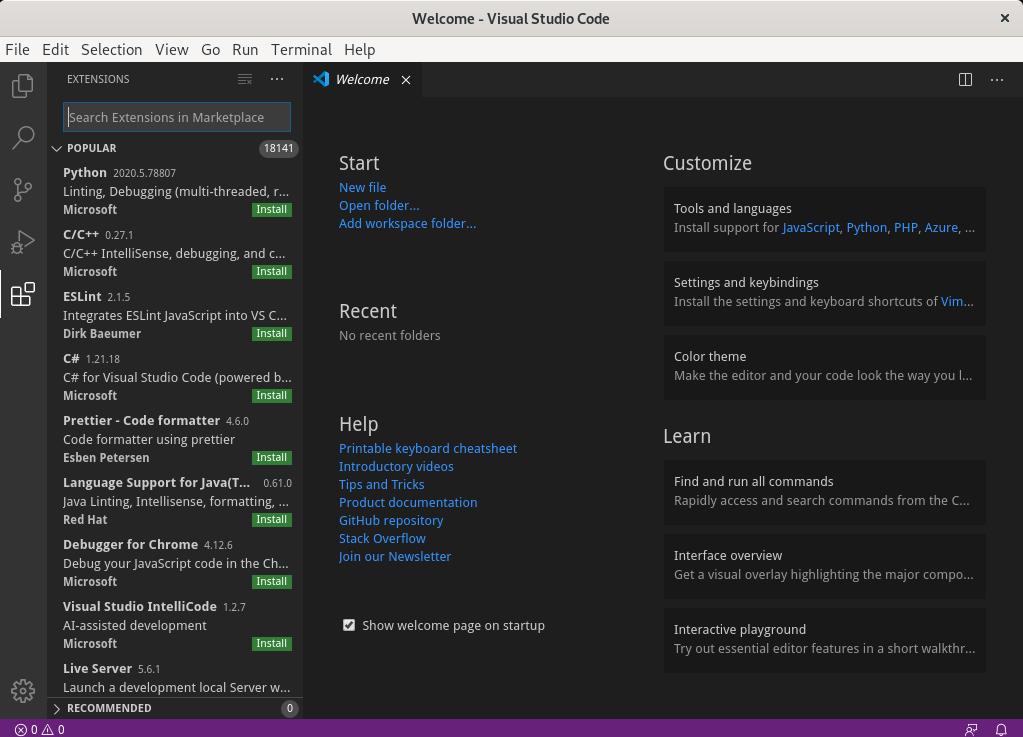 Search for and select `Remote-SSH` extension from Microsoft (should be the first one from the list)  Install the extension 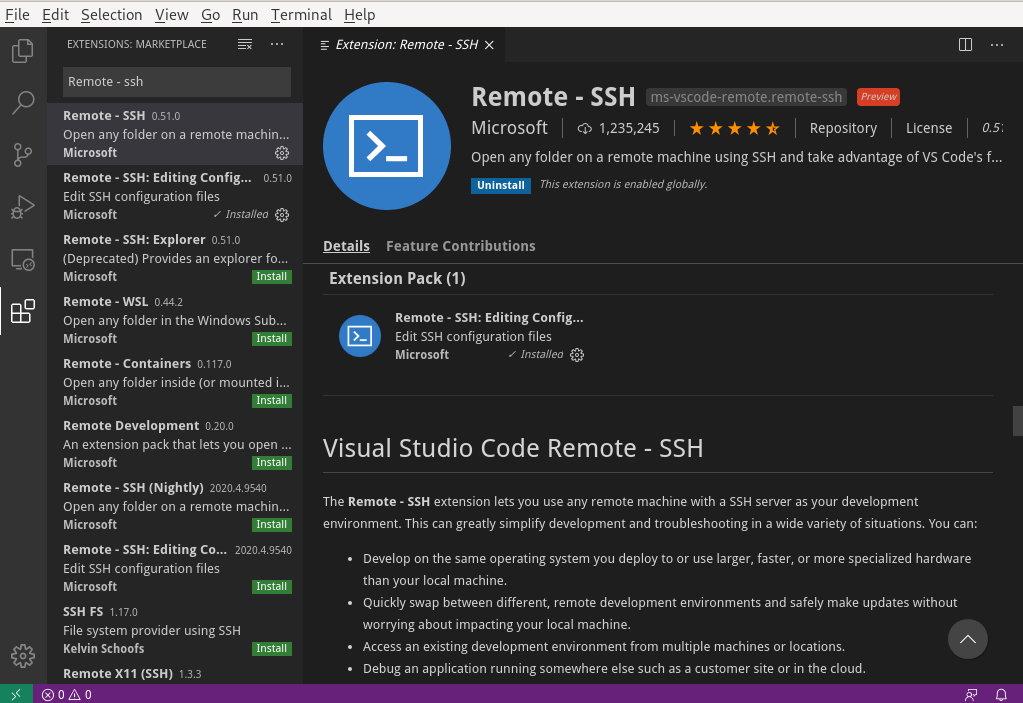 Go to `View > Command Pallete (or Ctr+Shift+P)` and search for the command `Remote-SSH: Connect to host...` to run a SSH session or `Remote-SSH: Add New SSH Host` to persist the host configurations for future usage. 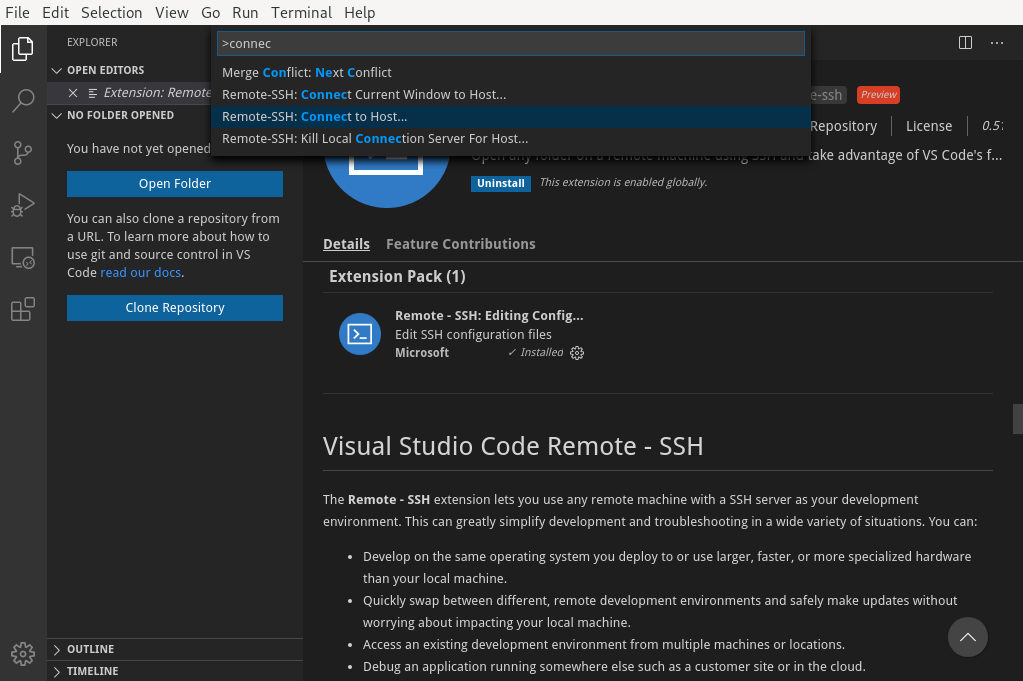 Input the hostname and enter. Add password/ssh key location when prompted 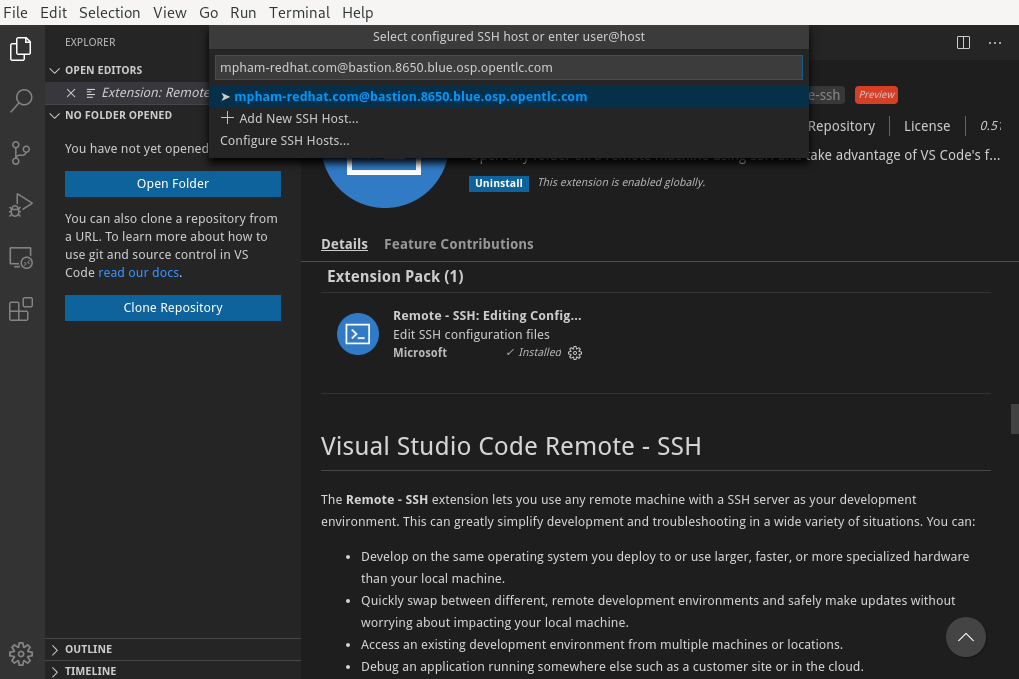 After vscode connects successfully to the hostname, we should see the hostname at the bottom left. Also go to `Terminal > New Terminal` will give us the direct ssh session with the host.  We then can have our remote workspace run on the host machine. Select `File > Open Folder (Ctrl+O)` to open the workspace 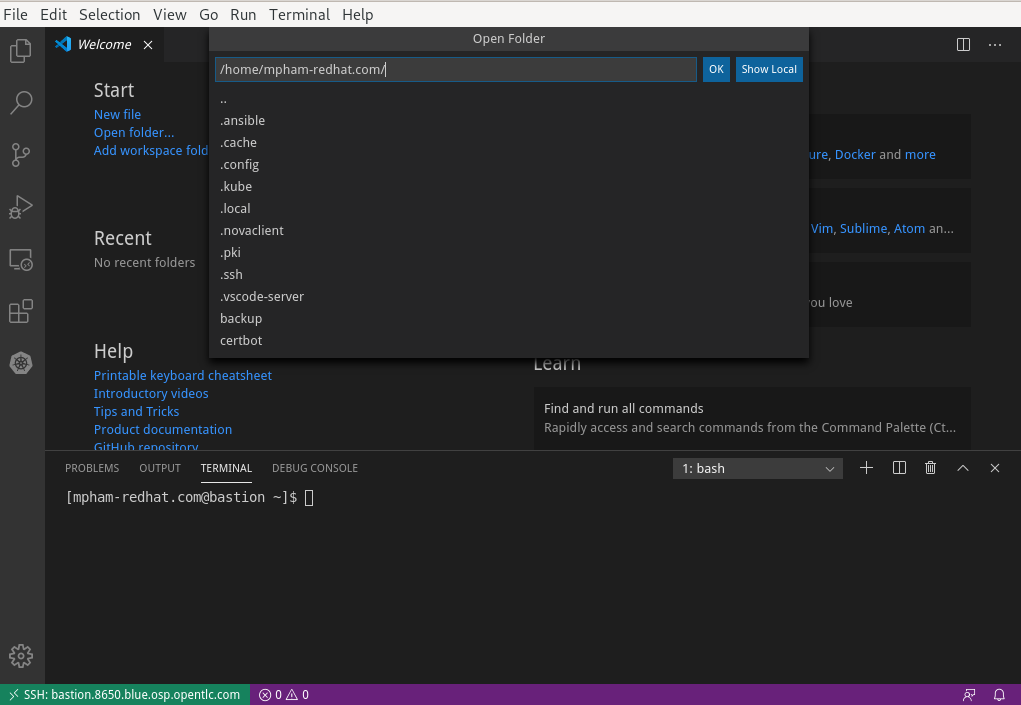 We can also install extensions on the remote workspace such as `yaml` from Red Hat and `kubernetes` 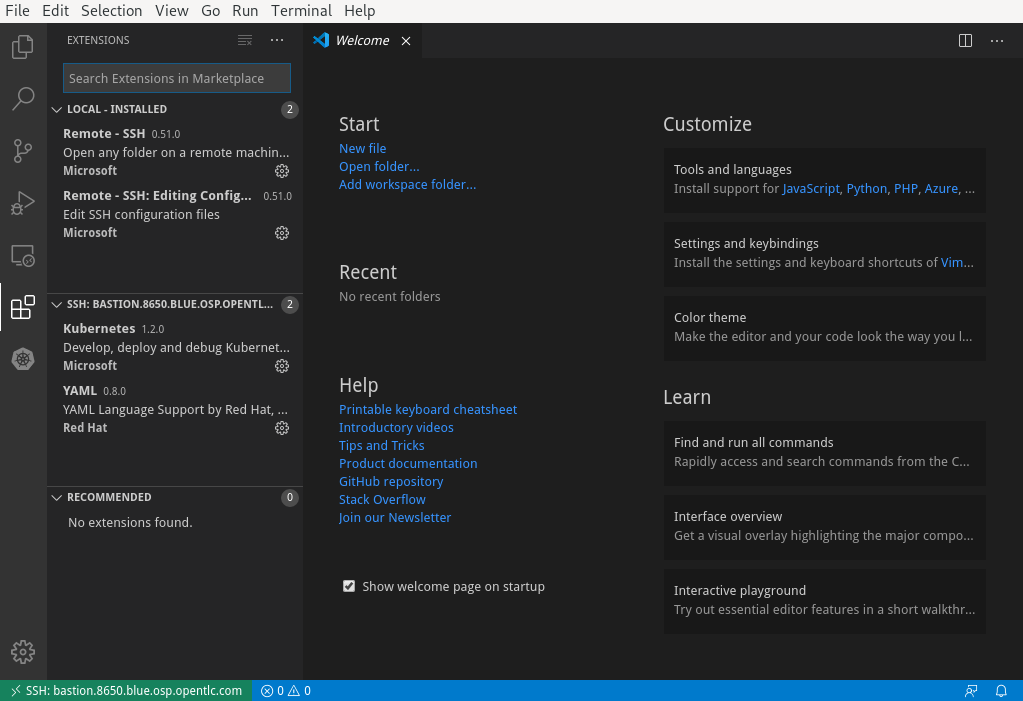 -
pnminh revised this gist
May 12, 2020 . 1 changed file with 1 addition and 1 deletion.There are no files selected for viewing
This file contains hidden or bidirectional Unicode text that may be interpreted or compiled differently than what appears below. To review, open the file in an editor that reveals hidden Unicode characters. Learn more about bidirectional Unicode charactersOriginal file line number Diff line number Diff line change @@ -9,7 +9,7 @@ $ sudo dnf install code $ code ``` Go to extension menu (`Ctrl+Shift+X`)  Search for and select `Remote-SSH` extension from Microsoft (should be the first one from the list)  -
pnminh revised this gist
May 12, 2020 . 1 changed file with 8 additions and 8 deletions.There are no files selected for viewing
This file contains hidden or bidirectional Unicode text that may be interpreted or compiled differently than what appears below. To review, open the file in an editor that reveals hidden Unicode characters. Learn more about bidirectional Unicode charactersOriginal file line number Diff line number Diff line change @@ -9,26 +9,26 @@ $ sudo dnf install code $ code ``` Go to extension menu (`Ctrl+Shift+X`)  Search for and select `Remote-SSH` extension from Microsoft (should be the first one from the list)  Install the extension  Go to `View > Command Pallete (or Ctr+Shift+P)` and search for the command `Remote-SSH: Connect to host...` to run a SSH session or `Remote-SSH: Add New SSH Host` to persist the host configurations for future usage.  Input the hostname and enter. Add password/ssh key location when prompted  After vscode connects successfully to the hostname, we should see the hostname at the bottom left. Also go to `Terminal > New Terminal` will give us the direct ssh session with the host.  We then can have our remote workspace run on the host machine. Select `File > Open Folder (Ctrl+O)` to open the workspace  We can also install extensions on the remote workspace such as `yaml` from Red Hat and `kubernetes`  -
pnminh revised this gist
May 12, 2020 . 1 changed file with 8 additions and 8 deletions.There are no files selected for viewing
This file contains hidden or bidirectional Unicode text that may be interpreted or compiled differently than what appears below. To review, open the file in an editor that reveals hidden Unicode characters. Learn more about bidirectional Unicode charactersOriginal file line number Diff line number Diff line change @@ -9,26 +9,26 @@ $ sudo dnf install code $ code ``` Go to extension menu (`Ctrl+Shift+X`)  Search for and select `Remote-SSH` extension from Microsoft (should be the first one from the list)  Install the extension  Go to `View > Command Pallete (or Ctr+Shift+P)` and search for the command `Remote-SSH: Connect to host...` to run a SSH session or `Remote-SSH: Add New SSH Host` to persist the host configurations for future usage.  Input the hostname and enter. Add password/ssh key location when prompted  After vscode connects successfully to the hostname, we should see the hostname at the bottom left. Also go to `Terminal > New Terminal` will give us the direct ssh session with the host.  We then can have our remote workspace run on the host machine. Select `File > Open Folder (Ctrl+O)` to open the workspace  We can also install extensions on the remote workspace such as `yaml` from Red Hat and `kubernetes`  -
pnminh created this gist
May 12, 2020 .There are no files selected for viewing
This file contains hidden or bidirectional Unicode text that may be interpreted or compiled differently than what appears below. To review, open the file in an editor that reveals hidden Unicode characters. Learn more about bidirectional Unicode charactersOriginal file line number Diff line number Diff line change @@ -0,0 +1,34 @@ # SSH Workspace ## Install VsCode On Fedora/RHEL/CentOS ```bash $ sudo rpm --import https://packages.microsoft.com/keys/microsoft.asc $ sudo sh -c 'echo -e "[code]\nname=Visual Studio Code\nbaseurl=https://packages.microsoft.com/yumrepos/vscode\nenabled=1\ngpgcheck=1\ngpgkey=https://packages.microsoft.com/keys/microsoft.asc" > /etc/yum.repos.d/vscode.repo' $ sudo dnf check-update $ sudo dnf install code $ code ``` Go to extension menu (`Ctrl+Shift+X`)  Search for and select `Remote-SSH` extension from Microsoft (should be the first one from the list)  Install the extension  Go to `View > Command Pallete (or Ctr+Shift+P)` and search for the command `Remote-SSH: Connect to host...` to run a SSH session or `Remote-SSH: Add New SSH Host` to persist the host configurations for future usage.  Input the hostname and enter. Add password/ssh key location when prompted  After vscode connects successfully to the hostname, we should see the hostname at the bottom left. Also go to `Terminal > New Terminal` will give us the direct ssh session with the host.  We then can have our remote workspace run on the host machine. Select `File > Open Folder (Ctrl+O)` to open the workspace  We can also install extensions on the remote workspace such as `yaml` from Red Hat and `kubernetes` 